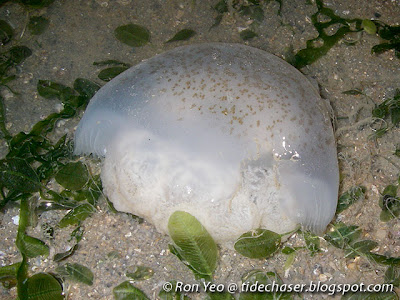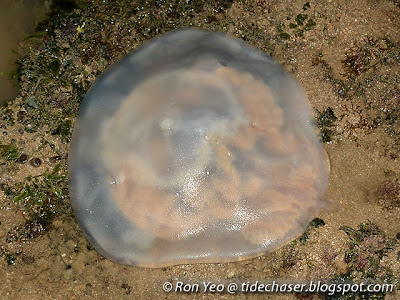Scyphozoan jellyfish (phylum Cnidaria, class Scyphozoa) are radially symmetrical animals which spend the majority of their lives as free-swimming individuals. The body of a jellyfish comprises a gelatinous umbrella-shaped bell housing a stomach (coelenteron) and a mouth surrounded by trailing tentacles. Like other cnidarians, they possess explosive, harpoon-like cells called cnidocytes. Each cnidocyte contains a secretory organelle (cnidae), which can be a nematocyst that discharges a harpoon-like stinger carrying toxins, a ptychocyst that discharges sticky substances, or a spirocyst that discharges lasso-like threads. Hence while cnidocytes are often called "stinging cells", they do perform other functions apart from stinging.
Apart from scyphozoans, other cnidarians such as hydroids and cubozoans also have jellyfish stages in their life cycle.

Scyphozoans may either feed on plankton by gathering them with their tentacles, or sting and paralyse bigger prey with their trailing tentacles. Some scyphozoans can sting very painfully, causing medical problems ranging from minor skin reactions to vomiting in human, and death cases have been reported.

Jellyfish are usually seasonally abundant in Singapore, and sometimes, hundreds can be seen in local waters. It is common to see some stranded on the beach during low tide as well.
Scyphozoans can reproduce sexually or asexually. In sexual reproduction, the male and female jellyfish of most species broadcast their eggs and sperm into the sea for external fertilisation. The females of some species, however, may brood the fertilised eggs. The fertilised egg develops into a free-swimming larva, and will eventually settle on suitable substrate to develop into a sessile form (called a polyp or more precisely, a scyphistoma), where they exist much like sea anemones, attached to the sea floor with their tentacles facing upwards. As the scyphistoma matures, it will either clone itself to form more polyps and each polyp will develop into the jellyfish form (called a medusa, or more precisely, a scyphomedusa for scyphozoan jellyfish), or produces the scyphomedusae by strobilation - a form of asexual reproduction which involves dividing the body into segments, and each segment will develop into a jellyfish.
From a commercial perspective, scyphozoan jellyfish are eaten as a delicacy in many Asian countries. In the wild, many big marine animals, such as sea turtles and some of the bigger fishes, feed on jellyfish.
The few jellyfish that I managed to identify were largely based on the information provided by Dr M. N. Dawson on his websites. Being no scientist, hopefully I got the identity right! If you spot any mistakes, or are able to identify any of those which I couldn't identify, please do drop me an email!
Family Catostylidae

Acromitus spp. possesses finger-like oral arms, each with a terminal whip-like appendage.

Here is a side view of an Acromitus sp. The bell is more than 10cm wide.

Catostylus spp. also have finger-like oral arms, but lacks the whip-like appendages. The bell is more than 10cm wide.
Family Cassiopeidae

The Upsidedown Jellyfish (Cassiopea sp.) is usually seen with its eight oral arms facing upwards, appearing like a sea anemone. It harbours the unicellular algae, zooxanthellae, which produce food through photosynthesis and share with the host jellyfish, in return for shelter and nutrients (waste products of the host). Since most of the algae are in the oral arms, being upside-down lying on the seabed will expose the algae to more sunlight and hence photosynthesize better.

Here is the Upsidedown Jellyfish with the right-side up. Studies have shown that they can release stingers in a layer of mucus into the surrounding water, and may cause rashes and itchiness if they touch a person's skin.

The colour of the Upsidedown Jellyfish may be green or brown. It can grow to rather big sizes with the bell more than 12cm wide.
Family Mastigiidae

This Mastigias sp. has oral arms with club-shaped extensions. The bell is spotted. I have only seen it a few times in Singapore, and they are usually rather small, with the bell about 5cm or less.
Family Pelagiidae

Chrysaora spp. usually has numerous tentacles attached to the margins of the bell, and several ribbon-like oral arms. Based on a paper published in 2012 by Nicholas Yap and Ong Joo Yong, the species above should be Chrysaora chinensis. It is usually pinkish orange or reddish in colour, has 24 long marginal tentacles, and faint reddish spots scattered evenly on the exterior of the bell. Sometimes called the Sea Nettle, Chrysaora species give very painful stings.

It appears to be seasonally abundant in Singapore, and sometimes hundreds can be seen. The bell can exceed 10cm wide.
Jellyfish I Couldn't Identify
The following are jellyfish which I could not identify using Dr Dawson's websites. If anyone can identify them, do drop me an email!

This white jellyfish appears much like a Chrysaora sp., with the marginal tentacles and ribbon-like oral arms. It's likely to be a related species or variation of the same species. The bell is about 6cm wide.

This bluish jellyfish is sometimes found stranded on our shores. I will estimate the bell to be about 20cm wide.

This purple jellyfish was seen only once. The bell is about 5cm wide.

This huge jellyfish is sometimes seen on our northern shores. The bell is more than 20cm wide.

This is possibly the biggest jellyfish that I have seen in Singapore so far, with the bell about 40cm wide!
References
Apart from scyphozoans, other cnidarians such as hydroids and cubozoans also have jellyfish stages in their life cycle.

Scyphozoans may either feed on plankton by gathering them with their tentacles, or sting and paralyse bigger prey with their trailing tentacles. Some scyphozoans can sting very painfully, causing medical problems ranging from minor skin reactions to vomiting in human, and death cases have been reported.

Jellyfish are usually seasonally abundant in Singapore, and sometimes, hundreds can be seen in local waters. It is common to see some stranded on the beach during low tide as well.
Scyphozoans can reproduce sexually or asexually. In sexual reproduction, the male and female jellyfish of most species broadcast their eggs and sperm into the sea for external fertilisation. The females of some species, however, may brood the fertilised eggs. The fertilised egg develops into a free-swimming larva, and will eventually settle on suitable substrate to develop into a sessile form (called a polyp or more precisely, a scyphistoma), where they exist much like sea anemones, attached to the sea floor with their tentacles facing upwards. As the scyphistoma matures, it will either clone itself to form more polyps and each polyp will develop into the jellyfish form (called a medusa, or more precisely, a scyphomedusa for scyphozoan jellyfish), or produces the scyphomedusae by strobilation - a form of asexual reproduction which involves dividing the body into segments, and each segment will develop into a jellyfish.
From a commercial perspective, scyphozoan jellyfish are eaten as a delicacy in many Asian countries. In the wild, many big marine animals, such as sea turtles and some of the bigger fishes, feed on jellyfish.
The few jellyfish that I managed to identify were largely based on the information provided by Dr M. N. Dawson on his websites. Being no scientist, hopefully I got the identity right! If you spot any mistakes, or are able to identify any of those which I couldn't identify, please do drop me an email!
Family Catostylidae

Acromitus spp. possesses finger-like oral arms, each with a terminal whip-like appendage.

Here is a side view of an Acromitus sp. The bell is more than 10cm wide.

Catostylus spp. also have finger-like oral arms, but lacks the whip-like appendages. The bell is more than 10cm wide.
Family Cassiopeidae

The Upsidedown Jellyfish (Cassiopea sp.) is usually seen with its eight oral arms facing upwards, appearing like a sea anemone. It harbours the unicellular algae, zooxanthellae, which produce food through photosynthesis and share with the host jellyfish, in return for shelter and nutrients (waste products of the host). Since most of the algae are in the oral arms, being upside-down lying on the seabed will expose the algae to more sunlight and hence photosynthesize better.

Here is the Upsidedown Jellyfish with the right-side up. Studies have shown that they can release stingers in a layer of mucus into the surrounding water, and may cause rashes and itchiness if they touch a person's skin.

The colour of the Upsidedown Jellyfish may be green or brown. It can grow to rather big sizes with the bell more than 12cm wide.
Family Mastigiidae

This Mastigias sp. has oral arms with club-shaped extensions. The bell is spotted. I have only seen it a few times in Singapore, and they are usually rather small, with the bell about 5cm or less.
Family Pelagiidae

Chrysaora spp. usually has numerous tentacles attached to the margins of the bell, and several ribbon-like oral arms. Based on a paper published in 2012 by Nicholas Yap and Ong Joo Yong, the species above should be Chrysaora chinensis. It is usually pinkish orange or reddish in colour, has 24 long marginal tentacles, and faint reddish spots scattered evenly on the exterior of the bell. Sometimes called the Sea Nettle, Chrysaora species give very painful stings.

It appears to be seasonally abundant in Singapore, and sometimes hundreds can be seen. The bell can exceed 10cm wide.
Jellyfish I Couldn't Identify
The following are jellyfish which I could not identify using Dr Dawson's websites. If anyone can identify them, do drop me an email!

This white jellyfish appears much like a Chrysaora sp., with the marginal tentacles and ribbon-like oral arms. It's likely to be a related species or variation of the same species. The bell is about 6cm wide.

This bluish jellyfish is sometimes found stranded on our shores. I will estimate the bell to be about 20cm wide.

This purple jellyfish was seen only once. The bell is about 5cm wide.

This huge jellyfish is sometimes seen on our northern shores. The bell is more than 20cm wide.

This is possibly the biggest jellyfish that I have seen in Singapore so far, with the bell about 40cm wide!
References
- Dawson, M. N. 2007. The Scyphozoan. Retrieved Jan 21, 2013, from http://thescyphozoan.ucmerced.edu.
- Dawson, M. N. 2012. The Scyphozoan Wiki. Retrieved Jan 21, 2013, from http://scyphozoan.ucmercedlibrary.info
- Morandini, A.C. & A.C. Marques. 2010. Revision of the genus Chrysaora Péron & Lesueur, 1810 (Cnidaria: Scyphozoa). Zootaxa 2464: 1–97.
- Ruppert, E.E. and R.D. Barnes. 1991. Invertebrate Zoology (International Edition). Saunders College Publishing. U.S.A. 1056 pp.
- World Register of Marine Species. 2012. Retrieved Jan 15, 2013, from http://www.marinespecies.org.
- Yap, W. L. N. & J. Y. Ong. 2012. A survey of jellyfish (Cnidaria) around St John's Island in the Singapore Straits. Contributions to Marine Science 2012: 57–74

1 comment:
nice post!possible species in order:
1)It is sure a Chrysaora. Possibly a variation of Chrysaora chinensis
2)Might be Lobonema sp or Lobonemoides sp
3)Looks like a Cyanea sp
4)Phyllorhiza punctata
5)A Rophilema. Possibly Rophilema hispidum
Post a Comment